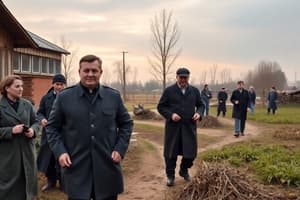Podcast
Questions and Answers
What was the primary goal of War Communism regarding labor?
What was the primary goal of War Communism regarding labor?
- To enforce mandatory work for able-bodied citizens (correct)
- To create unemployment for better productivity
- To prioritize agricultural work over industrial work
- To provide housing benefits for rural citizens
What significant issue arose under the New Economic Policy (NEP)?
What significant issue arose under the New Economic Policy (NEP)?
- Elimination of the rationing system
- Improvement in housing conditions for all
- Increased agricultural output
- Rising unemployment due to demobilization (correct)
What type of housing became common during the period from 1917-1953?
What type of housing became common during the period from 1917-1953?
- Komunalkas or communal apartments (correct)
- Single-family homes for factory workers
- Luxury apartments for elite citizens
- Workers' dormitories exclusively for males
What was a consequence of food shortages in factories during this time?
What was a consequence of food shortages in factories during this time?
What was one of the benefits established under Stalin's regime?
What was one of the benefits established under Stalin's regime?
Which group generally received fewer benefits during Stalin's welfare policies?
Which group generally received fewer benefits during Stalin's welfare policies?
What was one of the main outcomes of the housing distribution policies in the 1920s?
What was one of the main outcomes of the housing distribution policies in the 1920s?
What consequence did the Five-Year Plans have on the workforce?
What consequence did the Five-Year Plans have on the workforce?
Flashcards
War Communism
War Communism
A system of mandatory labor for Soviet citizens aged 16-50, involving work cards, social benefits, and rationing of food and fuel. Housing, transport, and amenities like laundries and crèches were provided.
What were the main features of War Communism?
What were the main features of War Communism?
A system of mandatory labor for Soviet citizens aged 16-50, under which people received work cards, social benefits, and rationing of food and fuel. Housing, transport, and amenities were provided.
How did the NEP impact unemployment and women's participation in the workforce?
How did the NEP impact unemployment and women's participation in the workforce?
The New Economic Policy allowed some private businesses to operate, which resulted in rising unemployment as soldiers were demobilized and workers were laid off to make industries more efficient. This policy also led to the abolishment of crèches, creating challenges for women in the workforce.
What impact did the Five-Year Plans have on employment and working conditions?
What impact did the Five-Year Plans have on employment and working conditions?
Signup and view all the flashcards
How did Stalin's government contribute to social benefits?
How did Stalin's government contribute to social benefits?
Signup and view all the flashcards
What challenges did peasants face in terms of social benefits and health?
What challenges did peasants face in terms of social benefits and health?
Signup and view all the flashcards
How did housing change in the Soviet Union during this period?
How did housing change in the Soviet Union during this period?
Signup and view all the flashcards
What were kommunalkas, and what were the living conditions like?
What were kommunalkas, and what were the living conditions like?
Signup and view all the flashcards
Study Notes
Social Development (1917-1953)
- Soviet policy aimed to fairly distribute wealth to all workers and peasants, though often prioritized economic goals.
- War Communism: Compulsory work for all citizens (16-50) was required in exchange for social benefits. Food and fuel were rationed. Other amenities were provided free to urban workers.
- The War Communism system failed due to insufficient rations and workers leaving factories for food in rural areas. Urban population decreased significantly during the Civil War.
- NEP: The economy changed. Soldiers returned and workers were laid off (demobilized/sacked) to streamline industry. Crèches were abolished, hindering women's participation in the workforce.
- The 1920s saw the development of a robust social benefit system covering medical, maternity, and unemployment benefits with the government investing heavily and trade unions administrating. The system covered 9 million urban workers.
- Stalin's Era: Compulsory work (reintroduced under Stalin) was part of a full employment policy. The Five-Year Plans led to increased female and male employment.
- Factories had harsh discipline, and conditions were often dirty and dangerous.
- Social benefits under Stalin included food rations and access to transportation. Vaccines were made available for diseases such as typhus and malaria. Factory canteens were provided.
- Problems with Welfare: Peasants received significantly fewer benefits than workers. Food shortages led to the use of rotten food, animal feed, and other unfit products in worker canteens, resulting in illness. Sanitation was poor in factories and farms, often resulting in infestations and disease outbreaks (lice, dysentery, etc.).
Housing
- Housing was a persistent problem from 1917-1953.
- In the 1920s, Soviet authorities redistributed existing housing, transferring it away from rich owners and giving it to poor citizens. This involved experimentation in architecture, such as the Narkomfin Apartment building.
- These projects, however, were expensive and rare. Existing housing was often divided into kommunalkas (communal apartments) with entire families living in single rooms, as small as 4-5.5 square meters.
- Whole families often lived in under-stairs cupboards or corridors.
- Barraks-style dormitories were constructed, often accommodating more workers than the beds available (e.g., 26,000 workers, but 15,000 beds).
Studying That Suits You
Use AI to generate personalized quizzes and flashcards to suit your learning preferences.




